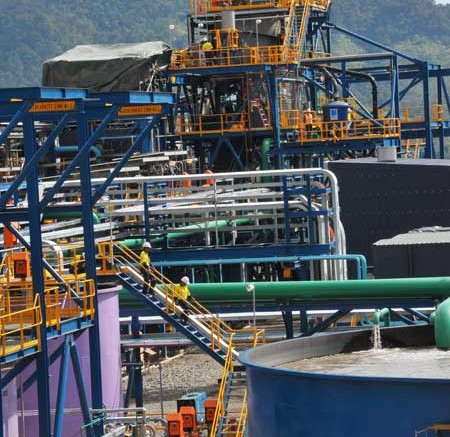OceanaGold (TSX: OGC; US-OTC: OGDCF; ASX: OGC) has reduced the mine life for its Macraes gold mine in New Zealand, but expects a strong production year at its new Didipio copper–gold mine in the Philippines, leaving many investors cheering.
“As a result of the prolonged and sustained drop in the gold price, the Macraes mine plan has been re-optimized to focus on lower-cost mining areas to sustain operations,” Sam Pazuki, OceanaGold’s manager of investor relations, said in an email. As result, mining rates at New Zealand’s largest gold mine will slump along with equipment use, and job cuts will follow.
The layoffs will impact 25% of the mine’s workforce, Pazuki says. Currently OceanaGold employs 455 permanent employees and another 110 contractors at Macraes. The job losses should begin in “the near future,” and will continue “over the next couple of years,” he adds.
The gold operation, located in the Otago region of New Zealand’s South Island, comprises the Macraes open pit and the Frasers underground mine. Production from the pit started in 1990 and commissioning of the underground mine kicked off in 2008.
At current gold prices, the mine life for the Frasers underground mine should conclude in mid-2015 and for the Macraes open pit at the end of 2017.
The revised mine plan shortens the mine life at Macraes by three years, with production wrapping up in 2017 instead of 2020, Brian Szeto, an analyst at Stonecap Securities, writes in a note.
Last June, the Melbourne-based firm also revised the mine plan for Reefton, its other open-pit gold mine on South Island. The operation is set to transition into care and maintenance in mid-2015.
Along with the recent changes at Macraes, the company announced its 2014 production guidance. It forecasts company-wide output of 275,000 to 305,000 oz. gold and 21,000 to 24,000 tonnes copper, at all-in sustaining costs of US$750 to US$850 per oz., net of by-product copper credits.
OceanaGold anticipates that its New Zealand operations will contribute 190,000 to 210,000 oz. gold to the company’s total, compared to last year’s target of 235,000 to 255,000 oz. The difference comes mainly from the lower production levels expected at Macraes following the new mine plan.
Pazuki said Reefton typically delivers 50,000 oz. gold a year, while production this year from Macraes is pegged at 150,000 to 160,000 oz.
But the silver lining in the 2014 output guidance is Didipio. OceanaGold expects the mine to churn out 85,000 to 95,000 oz. gold and 21,000 to 24,000 tonnes copper in 2014, compared to last year’s guidance of 50,000 to 70,000 oz. gold and 18,000 to 20,000 tonnes copper. All-in sustaining costs are estimated at negative US$240 to $210 per oz., net of copper by-product credits.
OceanaGold plans on increasing the mill throughput at Didipio to 3.5 million tonnes a year by the end of 2014, Pazuki says.
Stonecap’s Szeto says the production guidance at the company’s newest mine beat his expectations. “The fact that Didipio, the largest contributor to our [net asset value], is ramping up faster than expected is positive,” he says. But Szeto acknowledges the good news is “slightly offset” by the lower production and reduced mine life for the New Zealand operations.
BMO analyst Brian Quast also points to the rapid ramp-up at Didipio as a plus, but says the shorter mine life at Macraes could result in an impairment charge. The company is conducting an impairment review for its operations, which should be released in its 2013 year-end results.
To protect its gold sales from lower prices, OceanaGold plans to sell 208,000 oz. produced from Macraes in 2014 and 2015 through a “zero-cost” collar hedging program. The initiative will lock in the gold price at NZ$1,500 to $1,600 per oz. gold (US$1,230 to US$1,312 per oz.). The downfall of this is that if the gold spot price moves above NZ$1,600 per oz. over the next two years, the company will still receive NZ$1,600 per oz. for each ounce sold. Production from its Reefton mine was similarly hedged last June.
For capital spending this year, OceanaGold has budgeted US$80 million to US$100 million, of which US$50 million to US$60 million is for its New Zealand operations and the rest for Didipio. It has another US$5 million to US$10 million set aside for exploration in the Philippines and to maintain the newly acquired El Dorado project in El Salvador.
OceanaGold closed Jan. 10 up nearly 6% at $1.65, within a 52-week range of $1.04 to $2.97. It has a $495-million market capitalization.
Quast has trimmed his $2 target to $1.75 and rates the stock as “market perform.” Szeto maintains an “outperform” rating, but is in the midst of updating his $2.30-per-share valuation.


Be the first to comment on "OceanaGold sees a strong 2014 at Didipio"